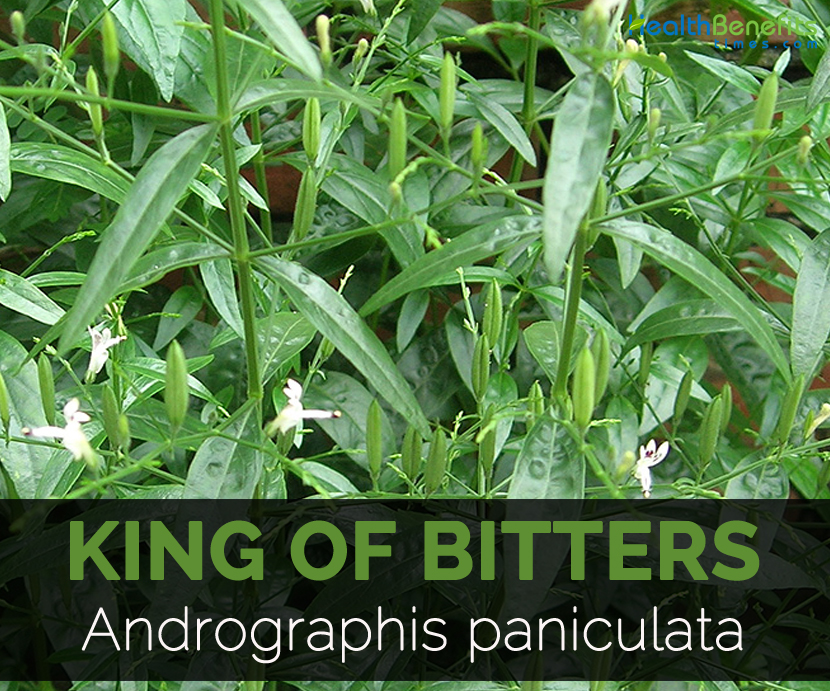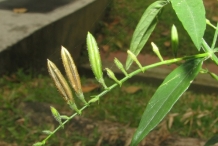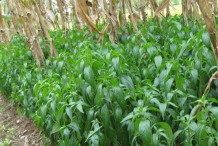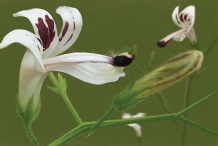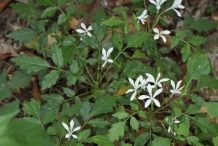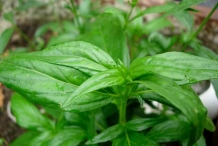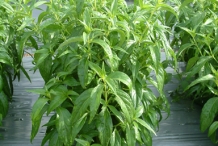It is also used in traditional medicine. The study shows that this plant helps to counteract the diseases such as infections, cancer, heart attacks, blood clots, diabetes, herpes, cold, gall bladder ailments, flu and fever. It also helps to prevent the allergies.
History
It is sophisticated in Southeastern and Southern Asia. Traditionally, it is used as a treatment for diseases and infections. The roots and leaves are used for the medicinal uses.
For the centuries, King of Bitters is used in India, Thailand, China and Asian countries. It is used to eliminate toxins and fevers. Kan Jang is an immunostimulant preparation that contains Kalmegh as well as eleutherococcus that was used for 20 years in Scandinavian countries. In United States, Kalmegh was marketed as well as manufactured.
Plant
It is an annual, herbaceous, evergreen, deciduous plant which grows upto the height of 30-100 cm (12-43 inches). Leaves simple, opposite, egg shaped, lance shaped upto 8 cm (3.1 inch) long by 2.5 cm (0.98 inch). The white flowers turn into a capsule which is 2 cm (0.79 inch) long and few millimeters wide. The slender stems are dark green. The fruit bears yellow to brown seeds.
Health benefits of King of Bitters
The herb is used historically to treat common cold, infections, flu and various diseases. It treats various ailments and diseases such as diarrhea, cholera, dysentery, swollen lymph nodes, pneumonia, leprosy, sore throats, bronchitis, tuberculosis, coughs, chicken pox, headaches, inflammation, ear infection, mumps and burns. This plant is bitter and possesses immunity enhancing properties that stimulates the immune system of the body. The researchers made by Japanese shows that it also prevents the multiplication of the cancer cells. The studies made in China helps to prevent the formation of blood clot. It is an effective treatment of heart attack and atherosclerosis. It has antioxidant properties which help to regulate diabetes by lowering the content of blood sugar. It is used in folk medicine for the treatment of digestive, urinary systems and cardiovascular problems.
- Treat various ailments
The studies conducted on the various respiratory tract infections. Andrographis paniculata possess anticancer, antidiabetic, hepaprotective and anti-inflammatory properties. It has therapeutic agents which help to treat various health ailments. The researchers target on the plant multiplication to reconcile the demand of the study. (1)
- Histamine level
The study shows that EAE, AEE and NBE along with AND, NAD and DDA rises the cell number and weight of PLNs. Moreover, monomers and various extract fractions rise the histamine level, cell degranulation and ammonia glycosidase. The extracts of King of Bitters have sensitizing capacity. (2)
- Prevent infections
The experiment shows that it possesses anti-inflammatory, antioxidant, antimicrobial, anticancer, antihyperglycemic, hepatoprotective and antihypoglycemic properties. The presence of andrographolide lowers common cold, sinusitis, HIV symptoms and rheumatoid arthritis. The researchers believe that it will be able to use for the treatment of cancer as well as inflammation in near future. (3)
- Prevents cancer
The extract of Andrographis paniculata prevents the formation of cancer. It interferes in the biomarker of the development of cancer which is caused due to the oxidative stress. It possesses antioxidant properties that act as a scavenger of free radicals. Moreover it regulates the epigenetic and genetic that displays the effect of chemoprotective. (4)
- Anti-inflammation
The extracts of Andrographis paniculata showed the results about the andrographolide compound as an anti-inflammatory property. Its extracts is used to investigate on the benefits and demerits while using to treat the body inflammation. (5)
- Treats diabetes
Diabetes has become the common disease in the world. The study shows that the extract of Indian plants helps to prevent disease and also used to treat cancer. It helps to manage Type 2 diabetes, hypertension, weight gain and suppression of immune. The extracts of the plant promote the uptake of glucose in the fat cells. (6)
- Prevent malaria
The research shows that the herbal combinations could counteract with the malarial parasites effectively. The combination of herbal drug along with curcumin prevents the formation of malarial parasites. (7)
- Anti-microbial
The study shows that the leaf extracts of A. paniculata, P.guajava and j.curcas possess the antimicrobial properties. It helps to manage the microbes by lowering the pH of preservative solution. The study shows the antimicrobial properties which requires test. The extracts of leaf acts as a biocides to manage the microbes. (8)
- Anti-oxidant properties
The study shows that Andrographis paniculata helps to treat the health problems such as acute diarrhea, respiratory tract infection, skin inflammations, wound healing as well as the bacterial infections. Further studies are still going on to know the properties of isolated bioactive compounds. (9)
- Reduce fatigue
The treatment using Andrographis paniculata helps to lower fatigue in the patients who are getting interferon beta treatment. The further study is required to determine the A. paniculata effect on the patients with fatigue. (10)
https://www.youtube.com/watch?v=UCP1Fx9SS8c
Traditional uses
- It is used since ancient times in tribal medicine of India.
- The plant of King of Bitters possesses febrifuge, alternative, tonic, stomachic, cholagogue and anthelmintic properties.
- It treats the liver complaints, constipation, colic, cholera, diarrhea, dysentery, dyspepsia, diabetes, general debility, hyper acidity, hookworm infestation, bronchitis, influenza, piles, malaria, swellings, gonorrhea, itches, scabies, stomachache and stomach disorders.
- It is an aid for jaundice and torpid liver.
- It is a cure for poisons of snake venom.
- The infusion of leaves provides relief from griping, loss of appetite and irregular bowels.
- It helps to cure the respiratory infections such as sinusitis and common cold.
- It treats influenza, bronchitis, fever and tonsillitis.
- Traditionally, it was used to improve immune function, urinary infections and acute diarrhea.
- It helps to enhance immunity and used to purify the blood purifier.
- It is also used to treat cholera and leprosy.
- It is the treatment for skin infection, boils, scabies and patches.
- The leaf extract helps to eliminate the stomach worms.
- It treats the scorpion and snake bite.
- It is used against heart disease and reduces high blood sugar.
Precautions
- The pregnant and breast feeding women should not use King of Bitters.
- It might increase the auto-immune disease symptoms.
- King of Bitters might slow down the clotting of blood. This increases the chances of bleeding.
- It lowers the blood pressure. So it is not safe for the patients of low blood pressure.
- It should not be used by the patients with gallbladder, kidney, cardiac, high blood pressure patients.
- It could worsen the ulcers or lead to heartburn.
- It could result to rashes or lose motions. In such cases, one should discontinue its use.
References:
https://en.wikipedia.org/wiki/Andrographis_paniculata
https://npgsweb.ars-grin.gov/gringlobal/taxonomydetail.aspx?id=414228
http://davesgarden.com/guides/pf/go/170849/
http://www.ars-grin.gov/misc/mmpnd/Andrographis.html
https://www.itis.gov/servlet/SingleRpt/SingleRpt?search_topic=TSN&search_value=184881#null
http://www.stfrancisherbfarm.com/pdf/Andrographis_Monograph.pdf
http://www.homeremediess.com/ayurvedic-herb-andrographis-paniculata/
http://www.hepatitiscfree.com/pdf/AndrographisPaniculata.pdf
http://www.herbal-supplement-resource.com/andrographis-herb.html
http://www.yogisherbs.com/nilavembu-king-bitters/
Comments
| King of Bitters Quick Facts | |
|---|---|
| Name: | King of Bitters |
| Scientific Name: | Andrographis paniculata |
| Origin | Native to Sri Lanka and India |
| Shapes | Capsule, Length: 2 cm (0.79 inch); Wide: few millimeters (Fruit) |
| Taste | Bitter |
| Health benefits | Treat various ailmentsm, Histamine level, Prevent infections, Prevents cancer, Anti-inflammation |
| More facts about King of Bitters | |
| Rank | Scientific Name & (Common Name) |
|---|---|
| Kingdom | Plantae (Plantes, Planta, Vegetal, plants) |
| Subkingdom | Viridiplantae |
| Infrakingdom | Streptophyta (Land plants) |
| Superdivision | Embryophyta |
| Division | Tracheophyta (Vascular plants, tracheophytes) |
| Sub division | Spermatophytina (Spermatophytes, seed plants, phanérogames) |
| Class | Magnoliopsida |
| Superorder | Asteranae |
| Order | Lamiales |
| Family | Acanthaceae (Acanthacées) |
| Genus | Andrographis Wall. ex Nees (False waterwillow) |
| Species | Andrographis paniculata (Burm. f.) Wall. ex Nees |
| Synonyms |
|


